Fans of the movie Sideways, the wine-drenched 2004 film following the debaucherous adventures of friends, Jack and Miles, in California wine country, will probably recall Miles’ disdain for one grape in particular…Merlot. His obvious, ahem, revulsion at the mere mention of it is really quite hilarious – click here to view but be warned, there’s a smidge of profanity!
The irony in the film, however, is that Miles’ most treasured bottle in his wine collection is a 1961 Château Cheval Blanc, a highly coveted, collectible bottle made of mostly…wait for it…MERLOT! Perhaps the wine’s status as one of the most revered Bordeaux wines in existence made it possible for him to overcome his Merlot-phobia? It’s hard to say, but thoughts of the film had us smiling as we eased into the gravel drive of Château Cheval Blanc on a hauntingly beautiful, overcast September day.


Located in rural Saint-Émilion among the lush greenery of Bordeaux’s Right Bank, we were looking forward to visiting this revered estate whose terroir has been highly regarded since the 15th century. The estate currently produces two wines, the eponymous Château Cheval Blanc as well as a second wine, La Petit Cheval, which made its debut in the 1988 vintage. In addition to its wines, the Château had also recently completed a major renovation which we were also very eager to experience.

But first, a little vinous history. Since the Saint-Émilion classification system’s inception in 1954, Cheval Blanc has been categorized as a Premier Cru Classe A, the system’s highest level. The Chateau shares this distinction with only three other producers: Château Ausone, Château Pavie and Château Angélus. While Cheval Blanc and Ausone have been exclusive members of this prestigious classification since the beginning, the 2012 update added Chateaux Pavie and Angélus.


The property now known as Château Cheval Blanc, French for “white horse,” was once part of a larger, 200-hectare estate known as Château Figeac. While vines have been grown here for centuries, it wasn’t until a man by the name of Jean-Jacques Ducasse purchased a portion of the estate in 1832, that the core of what many would consider the finest Chateau in all of Bordeaux was formed. Over the next 20 years, the family continued to add land to estate until it reached 39 hectares which is where it still stands today.
When Jean-Jacques’ daughter Henriette married Jean Laussac-Fourcaud, a Libourne wine merchant, a new chapter in the evolution of Château Cheval Blanc began. In the 1860’s, Laussac-Fourcaud’s keen intuition led him to replant the vineyards to half Merlot and half Cabernet Franc, the two grapes which, to this day, thrive on Bordeaux’s Right Bank. He also realized the importance of water stress in order to produce the finest grapes possible. Formerly known as vin de Figeac, the wine was first sold under the Cheval Blanc name in 1852.

For thirty years, Jean Laussac-Fourcaud dedicated himself to one thing only, making the wines of Château Cheval Blanc the best in Saint-Émilion! His hard work paid off and his wines won many awards over the years and developed a reputation of excellence. In the 1880’s Cheval Blanc was even considered on par with the finest wines of the Médoc, garnering similar prices as wines from the famed Chateaux Margaux, Latour, Lafite and Haut-Brion. Once Jean Laussac-Fourcaud passed away, his son Albert inherited the Chateau and perpetuated the work of his father and made even more improvements in the vineyard. By the time Albert’s two sons, Jacques and Joseph, inherited the estate, they too followed in the footsteps of their father and grandfather before them.
Over the ensuing decades, acknowledgements of excellence continued to solidify the family’s legacy including the aforementioned appointment in the Saint-Emilion Classification system as Premier Grand Cru Classé “A.” This exalted rank was perpetuated in each following classification update and Cheval Blanc became a member of the exclusive “Club of 9” comprising the first growths of Bordeaux. Perhaps cellarmaster of Cheval Blanc for 44 years, Gaston Vaissière, summed it up best when he deemed the vineyards’ terroir “magical.”

Another important chapter of the Cheval Blanc story commenced in the Autumn of 1998 when Bernard Arnault and Baron Albert Frère, old friends and lovers of great wine, joined forces to purchase the fabled château. They brought on Pierre Lurton as Estate Manager and injected a dynamic new spirit into the Château while maintaining the utmost reverence and respect for its history. They also placed their complete trust in the winemaking team to continue their wonderful work. The priority today continues to be producing wines of the utmost quality, which calls for enormous attention to detail and winemaking precision.
With a vision towards the future, the duo embarked on the addition of a new, state-of-the-art cellar adjacent to the Château. The impressively modern structure was designed by Christian de Portzamparc, winner of the Pritzker Architecture Prize in 1994, and was completed in June 2011. Reflecting the taste of the Château owners, the addition is both futuristic and in keeping with the surrounding historic vineyard landscape which is listed as a World Heritage Site by UNESCO. The new Cheval Blanc cellar was extremely well-received and the first structure in its category to be certified for the High Quality Environmental (HQE) standard. With its uber-stringent criteria, this certification recognizes great care taken in choosing building materials, energy conservation, waste water management as well as acoustic comfort and employee well-being.



On our tour of the new facility, we felt like we were walking on truly hallowed ground. The new cellar’s intimate yet airy feel exuded elegance with its monochromatic colors and diffused natural light. One of the most striking interior vistas features six rows of curvilinear Italian concrete vats stoically flanking a walkway and stairwell down to the barrel room. The number of vats correlates exactly with the Chateau’s fifty two vineyard plots, allowing each one to be vinified separately, a very important component in the production of the Cheval Blanc wines. Each bespoke vat is individually tailored to the size of its assigned vineyard plot and labelled with its corresponding plot number, grape variety and the number of hectoliters the plot produces. The temperature of each vat is also individually controlled and monitored by a super sophisticated control panel. The integration of tech-savvy features and sophisticated aesthetics in this impressive structure was truly amazing!


One level below the tank room was the extensive underground barrel cellar where French barriques cradled the aging wine. The artfully displayed barrels were illuminated by the soft glow of stylish, low-hanging pendant lighting. The cellar’s beautiful Mashrabiya walls, inspired by traditional Arabic wooden screens, served the dual purpose of concealing machinery and equipment while facilitating ventilation. Standing amidst the barrels, the intimate, elegant space felt more like a chic hotel lobby than what you’d expect to find in a musty wine cellar.


After we toured the cellar’s interior we were led up to the rooftop which featured beautiful gardens and panoramic views of the bucolic splendor surrounding the estate. The view also included the vineyards of another world renowned estate, Chateau Pétrus, which is only a stone’s throw away in neighboring Pomerol. While the prestigious Chateaux and vast holdings of the Left Bank are certainly very impressive, we were truly smitten with the verdant lush greenery and relaxed charm of the Right Bank.

Finally, we toured the estate’s vineyards and were able to walk among its revered vines. As we meandered down the gravel paths we were able to pluck some of the Cabernet Franc grapes straight from the vine. Since it was September just before harvest, the grapes were juicy and perfectly ripe. After we had each sampled a few of the delightful jewels, we were ushered away from the vineyard in order to avoid cutting into their profits!

Understandably, the soil types the vines are grown in is particularly important for maintaining the character of the Cheval Blanc wines. While some estates in Saint-Emilion have excellent gravelly soil, and others have very good clay soils, Cheval Blanc is blessed with both types of soil in fairly equal proportions. Château Cheval Blanc is also one of the rare estates whose vineyard configuration has remained practically identical for nearly a century and a half, since 1871. This continuity can also to be found in the proportion of grape varieties. In 1911, the share of Cabernet Franc was also close to 50%.


The vineyards at Château Cheval Blanc are planted to three classic Bordeaux grape varieties: 49% Cabernet Franc, 47% Merlot and 4% Cabernet Sauvignon. The average age of the vines is 42 years, but the oldest plots go back to 1920. Replanting is done at a very slow rate – only one hectare every three years. This means that, year in and year out, the heart of Cheval Blanc’s vineyard remains intact.
Each vineyard plot has its own specific profile due to the age of the vines, surface area, kind of soil, type of rootstock and grape variety. As a result, the wine produced from each plot has its own unique profile. Those from clay soil are powerful with velvety tannin, while those from gravel soil are more aromatic and elegant. A blend of the two results in a wine that is both powerful and elegant with expressive aromatics as well as the complexity of Bordeaux’s greatest wines.

After our fabulous tour of Château Cheval Blanc we sampled the Chateau’s 2006 vintage, a blend of 54% Merlot, 45% Cabernet Franc and 1% Cabernet Sauvignon. 2006 was a year which highly favored Merlot, resulting in a wine with rich, ripe, expressive fruit which melded beautifully with the elegance of the Cabernet Franc. The full-bodied wine was rife with layered notes of violet, cassis, cocoa, leather and cigar box which continued to evolve and mesmerize in the glass. The wine’s opulence was balanced by its elegant frame and fine tannins, which demonstrated remarkable balance and poise. We took our glasses up to the rooftop garden to fully savor and indulge in the experience…right down to the very last drop.
Are you a Bordeaux fan? Why or why not and if you are, which bank do YOU prefer, Right or Left? Please let me know in the Comments section below!
Bon appétit,
![]()
The post A Visit to Bordeaux’s Iconic Château Cheval Blanc appeared first on The Glamorous Gourmet.
After recently dining at The Ordinary in Charleston, South Carolina, I'd have to say Chef Mike Lata's "fancy" oyster bar and seafood hall is nothing short of - EXTRAordinary! Ensconced in an historic bank building with soaring ceilings and quaint architectural details, we were smitten by this charming eatery. Every aspect of our experience made it abundantly clear why the restaurant garnered a coveted James Beard Award nomination for Best New Restaurant in 2013.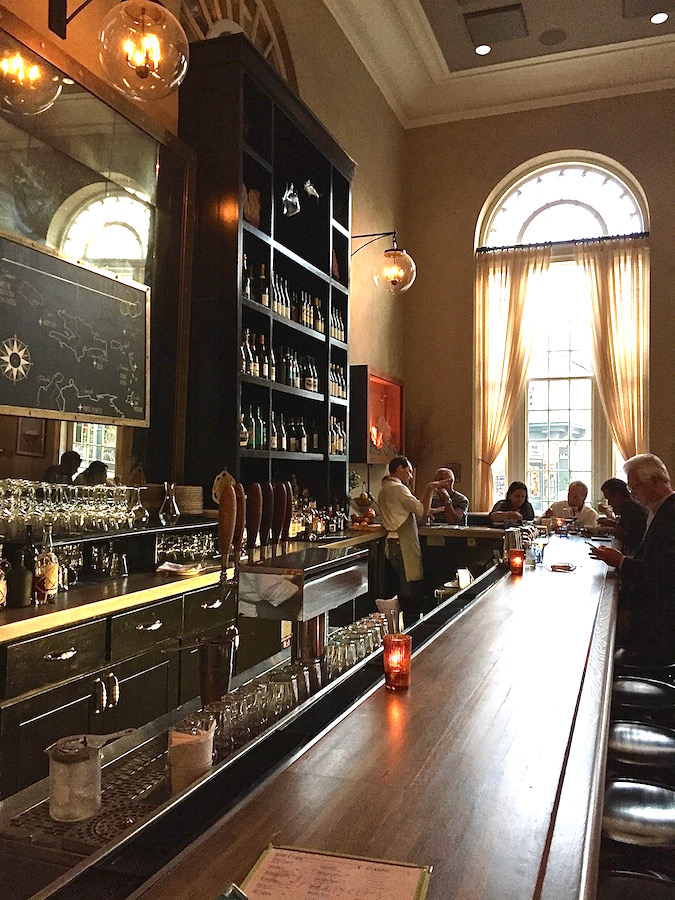 Awarded "Best Chef Southeast" by the James Beard Foundation in 2009, Chef Lata is widely considered a pioneer of Charleston's vibrant culinary scene. His first establishment, FIG (short for "Food Is Good"), which he opened in 2003 with partner Adam Nemirow, set Charleston's culinary bar high. While FIG celebrates the bounty of the Lowcountry, The Ordinary pays homage to the "merroir" (the oceanic version of "terroir") of the coastal Carolinas. Using unique types of seafood in inventive, yet not highly manipulative preparations is an intrinsic part of the not-so-ordinary experience.
Awarded "Best Chef Southeast" by the James Beard Foundation in 2009, Chef Lata is widely considered a pioneer of Charleston's vibrant culinary scene. His first establishment, FIG (short for "Food Is Good"), which he opened in 2003 with partner Adam Nemirow, set Charleston's culinary bar high. While FIG celebrates the bounty of the Lowcountry, The Ordinary pays homage to the "merroir" (the oceanic version of "terroir") of the coastal Carolinas. Using unique types of seafood in inventive, yet not highly manipulative preparations is an intrinsic part of the not-so-ordinary experience.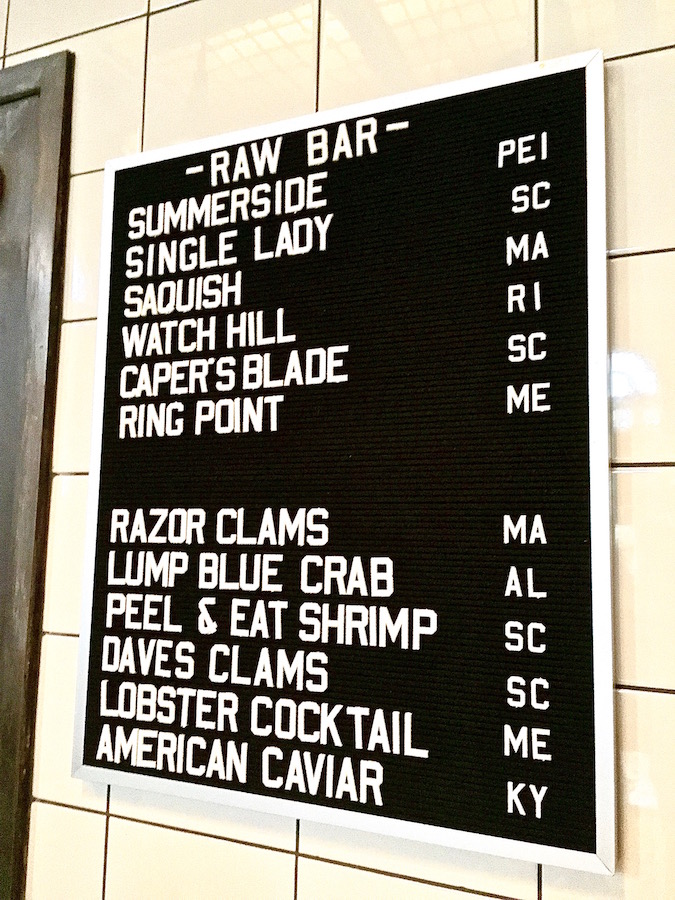
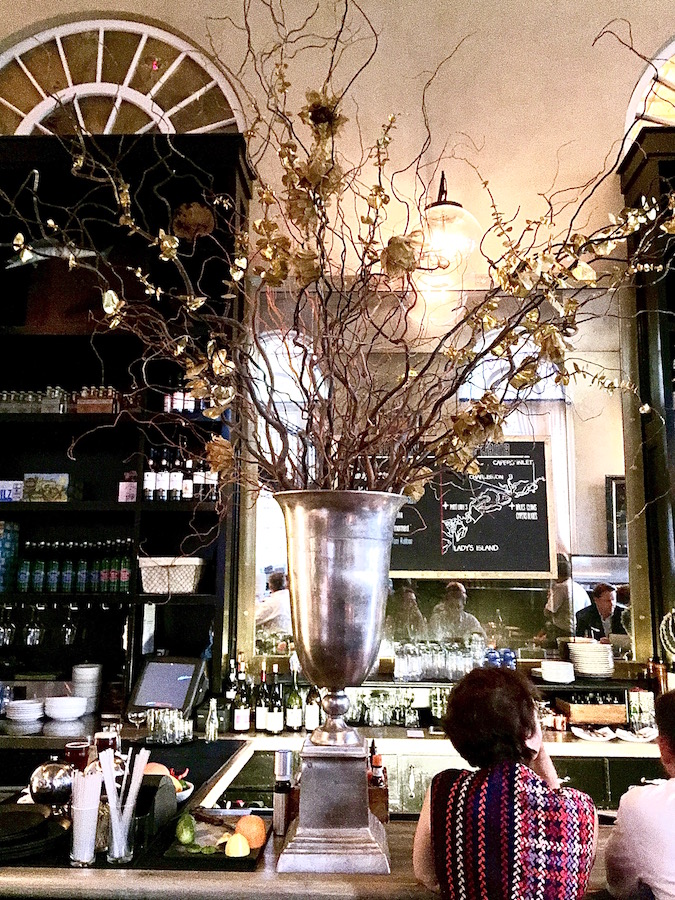 In addition to the fabulous coastal cuisine, another highlight at The Ordinary is its spectacular staff. Although we made reservations in advance, we decided to dine at the bar (highly recommend!) and our team of bartenders/servers expertly guided us through the menu and wine list. These passionate ambassadors made exploring the menu a delightful adventure, recommending delectable dishes including savory Smoked Oysters with Saltines and Hot Sauce, a fresh and flavorful Porgy Ceviche with Avocado and Cucumber, heavenly Steak Tartare with Crispy Oysters & Horseradish and peel and eat BBQ White Shrimp (worth the mess!) served with charred bread to sop up all the heavenly sauce. Since I'm not a fan of raw oysters, Steve "volunteered" to knock back a sampling of these coastal gems which were exceptional!
In addition to the fabulous coastal cuisine, another highlight at The Ordinary is its spectacular staff. Although we made reservations in advance, we decided to dine at the bar (highly recommend!) and our team of bartenders/servers expertly guided us through the menu and wine list. These passionate ambassadors made exploring the menu a delightful adventure, recommending delectable dishes including savory Smoked Oysters with Saltines and Hot Sauce, a fresh and flavorful Porgy Ceviche with Avocado and Cucumber, heavenly Steak Tartare with Crispy Oysters & Horseradish and peel and eat BBQ White Shrimp (worth the mess!) served with charred bread to sop up all the heavenly sauce. Since I'm not a fan of raw oysters, Steve "volunteered" to knock back a sampling of these coastal gems which were exceptional!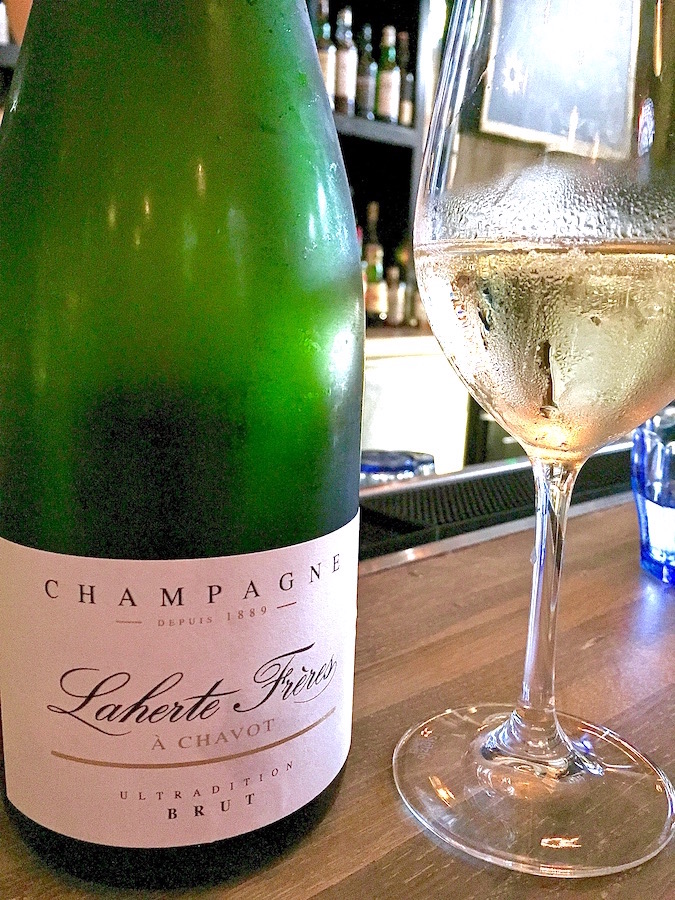
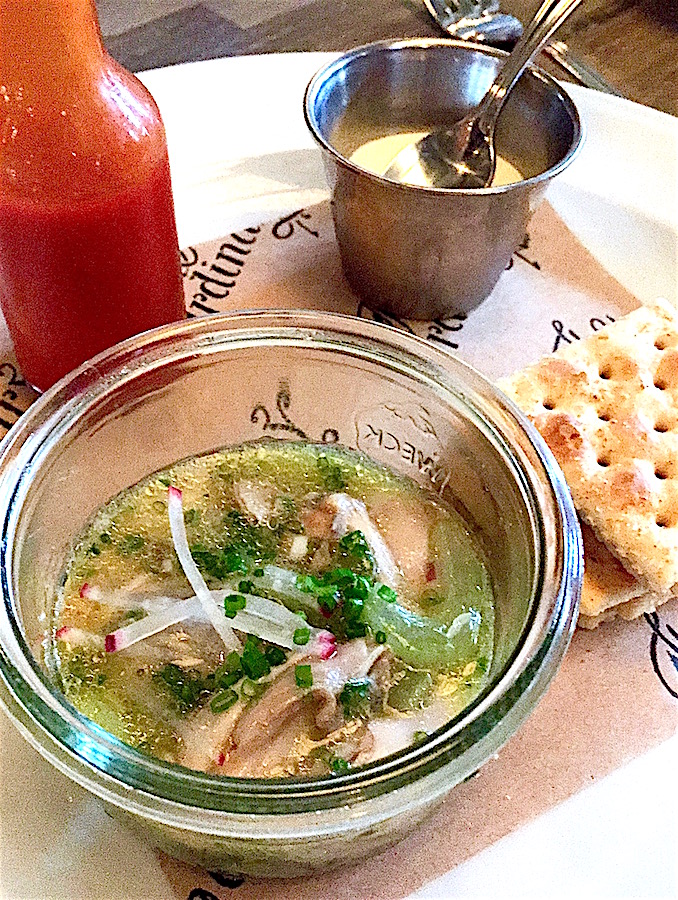 On par with The Ordinary's passion for coastal cuisine is their enthusiasm for wine. The wine list offers a wide range of offerings from around the globe specifically selected to complement the menu. But, if you're looking for your usual Chardonnay or Cabernet Sauvignon, you're not going to find it here. The Ordinary is definitely the place to go for vinous exploration featuring esoteric selections including a sparkling German Sekt, a Corsican red blend of Sciaccarello and Nielluccio and entire sections devoted to Pink & Orange wines and Sherry. The list is rounded out nicely by a selection of delicious craft cocktails, daiquiris, vermouths, beers and ciders as well as 31 different types of rum from five countries.
On par with The Ordinary's passion for coastal cuisine is their enthusiasm for wine. The wine list offers a wide range of offerings from around the globe specifically selected to complement the menu. But, if you're looking for your usual Chardonnay or Cabernet Sauvignon, you're not going to find it here. The Ordinary is definitely the place to go for vinous exploration featuring esoteric selections including a sparkling German Sekt, a Corsican red blend of Sciaccarello and Nielluccio and entire sections devoted to Pink & Orange wines and Sherry. The list is rounded out nicely by a selection of delicious craft cocktails, daiquiris, vermouths, beers and ciders as well as 31 different types of rum from five countries.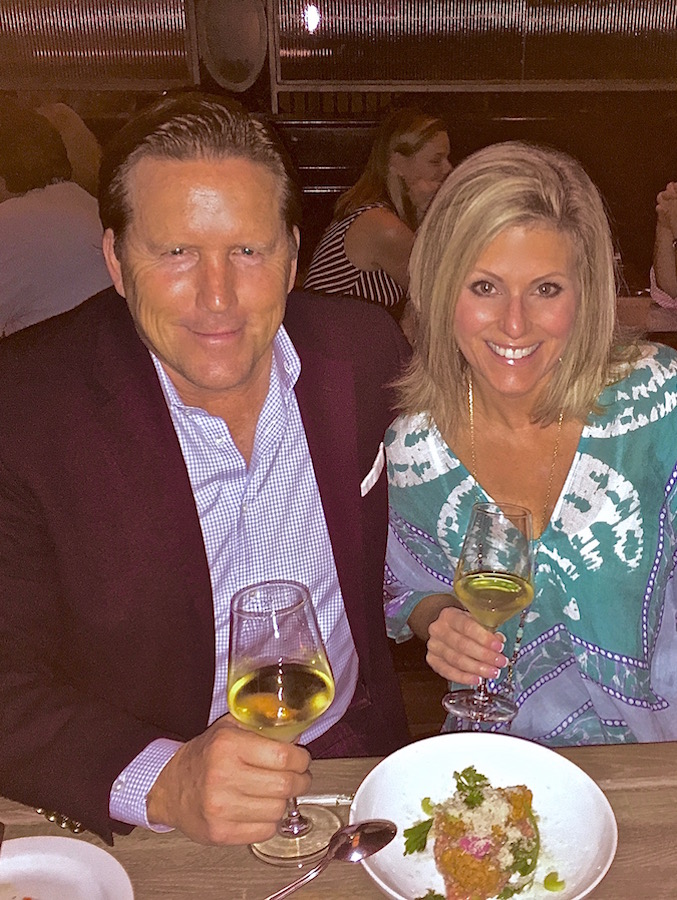
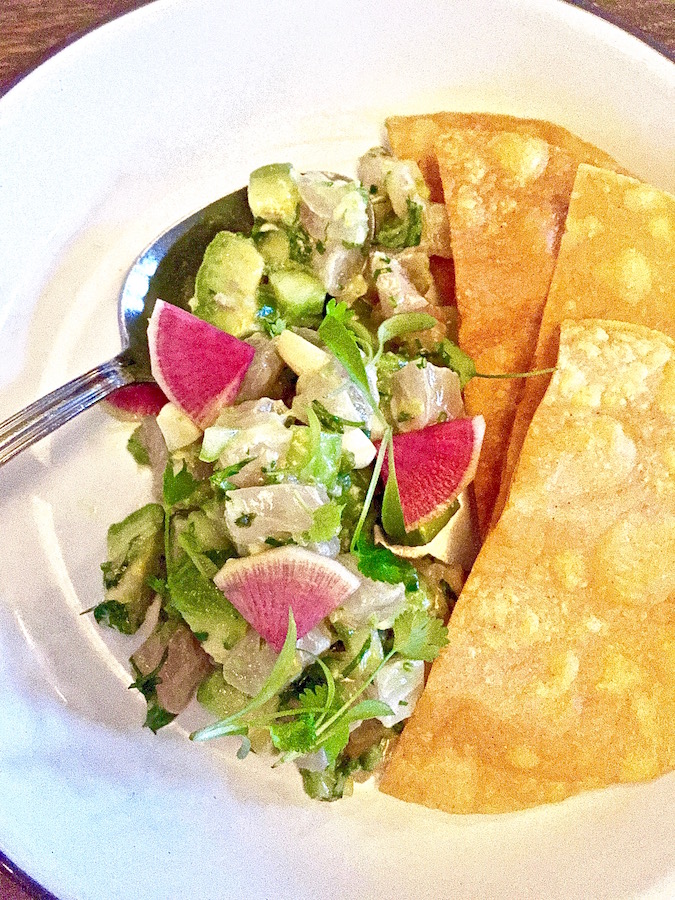
 We started with their stellar Champagne by the glass, the Laherte Frères Ultradition Brut. It was crisp and vibrant with a refreshing minerality - the perfect choice to prime our palates! We continued to sample a variety of wines with our delicious dishes including another bubbly, the frothy, fresh Albert Mann Cremant d'Alsace, as well as the 2015 Dirty & Rowdy "Familiar Blanc," a quirky white blend from California. A citrusy Chenin Blanc from the Loire's Château de Fosse-Sèche rounded out the whites before we sampled our only red wine of the night, a 2014 Domaine de la Pinte Poulsard "Pinte Bien." You see, red wines are in the minority at The Ordinary, outnumbering reds 25 to 10. Given this extraordinary seafood-focused menu - it totally works!
We started with their stellar Champagne by the glass, the Laherte Frères Ultradition Brut. It was crisp and vibrant with a refreshing minerality - the perfect choice to prime our palates! We continued to sample a variety of wines with our delicious dishes including another bubbly, the frothy, fresh Albert Mann Cremant d'Alsace, as well as the 2015 Dirty & Rowdy "Familiar Blanc," a quirky white blend from California. A citrusy Chenin Blanc from the Loire's Château de Fosse-Sèche rounded out the whites before we sampled our only red wine of the night, a 2014 Domaine de la Pinte Poulsard "Pinte Bien." You see, red wines are in the minority at The Ordinary, outnumbering reds 25 to 10. Given this extraordinary seafood-focused menu - it totally works!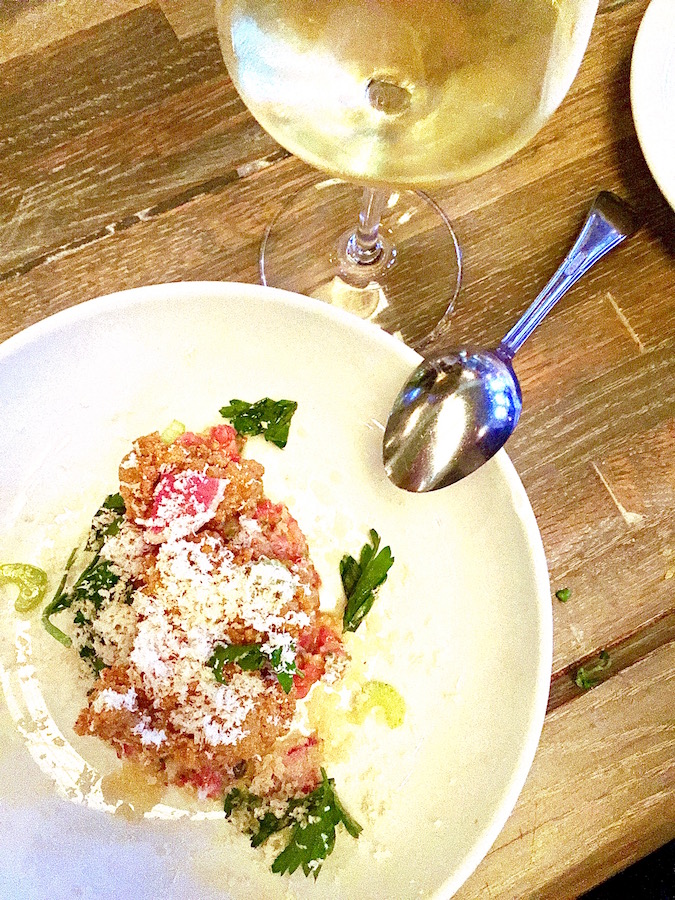
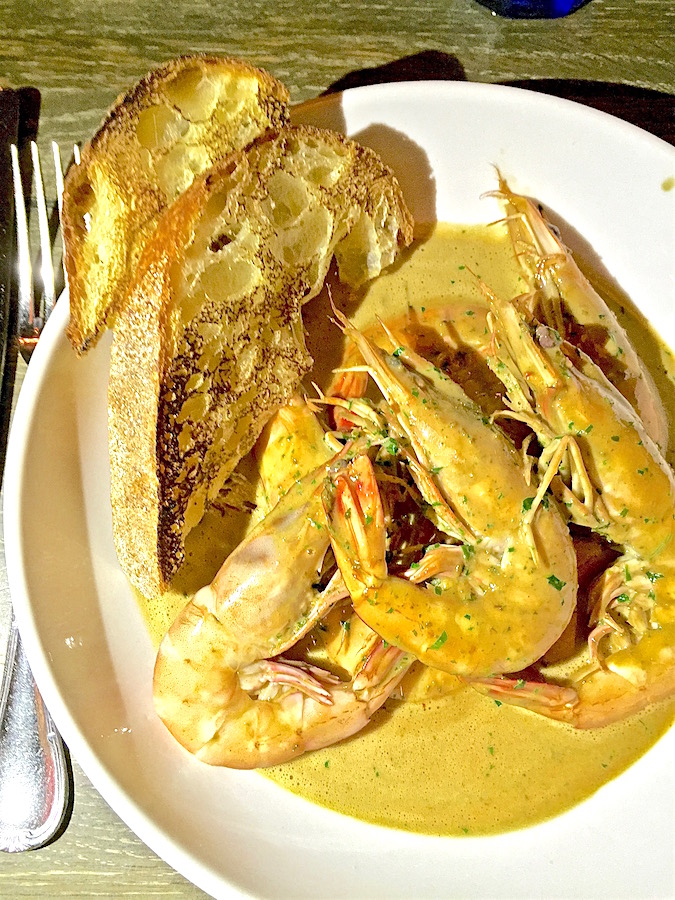 So next time you're in Charleston and hankering for an exceptional meal featuring some of South Carolina's best seafood, be sure to visit The Ordinary. I'm sure your experience will be nothing short of extraordinary.The Ordinary544 King StreetCharleston, SC843.414.7060www.eattheordinary.comCheers,
So next time you're in Charleston and hankering for an exceptional meal featuring some of South Carolina's best seafood, be sure to visit The Ordinary. I'm sure your experience will be nothing short of extraordinary.The Ordinary544 King StreetCharleston, SC843.414.7060www.eattheordinary.comCheers,
After recently dining at The Ordinary in Charleston, South Carolina, I’d have to say Chef Mike Lata’s “fancy” oyster bar and seafood hall is nothing short of – EXTRAordinary! Ensconced in an historic bank building with soaring ceilings and quaint architectural details, we were smitten by this charming eatery. Every aspect of our experience made it abundantly clear why the restaurant garnered a coveted James Beard Award nomination for Best New Restaurant in 2013.

The inviting bar at The Ordinary
Awarded “Best Chef Southeast” by the James Beard Foundation in 2009, Chef Lata is widely considered a pioneer of Charleston’s vibrant culinary scene. His first establishment, FIG (short for “Food Is Good”), which he opened in 2003 with partner Adam Nemirow, set Charleston’s culinary bar high. While FIG celebrates the bounty of the Lowcountry, The Ordinary pays homage to the “merroir” (the oceanic version of “terroir”) of the coastal Carolinas. Using unique types of seafood in inventive, yet not highly manipulative preparations is an intrinsic part of the not-so-ordinary experience.


In addition to the fabulous coastal cuisine, another highlight at The Ordinary is its spectacular staff. Although we made reservations in advance, we decided to dine at the bar (highly recommend!) and our team of bartenders/servers expertly guided us through the menu and wine list. These passionate ambassadors made exploring the menu a delightful adventure, recommending delectable dishes including savory Smoked Oysters with Saltines and Hot Sauce, a fresh and flavorful Porgy Ceviche with Avocado and Cucumber, heavenly Steak Tartare with Crispy Oysters & Horseradish and peel and eat BBQ White Shrimp (worth the mess!) served with charred bread to sop up all the heavenly sauce. Since I’m not a fan of raw oysters, Steve “volunteered” to knock back a sampling of these coastal gems which were exceptional!

We looooved their Champagne by the glass!

Smoked Oysters with Hot Sauce = DIVINE!
On par with The Ordinary’s passion for coastal cuisine is their enthusiasm for wine. The wine list offers a wide range of offerings from around the globe specifically selected to complement the menu. But, if you’re looking for your usual Chardonnay or Cabernet Sauvignon, you’re not going to find it here. The Ordinary is definitely the place to go for vinous exploration featuring esoteric selections including a sparkling German Sekt, a Corsican red blend of Sciaccarello and Nielluccio and entire sections devoted to Pink & Orange wines and Sherry. The list is rounded out nicely by a selection of delicious craft cocktails, daiquiris, vermouths, beers and ciders as well as 31 different types of rum from five countries.



We started with their stellar Champagne by the glass, the Laherte Frères Ultradition Brut. It was crisp and vibrant with a refreshing minerality – the perfect choice to prime our palates! We continued to sample a variety of wines with our delicious dishes including another bubbly, the frothy, fresh Albert Mann Cremant d’Alsace, as well as the 2015 Dirty & Rowdy “Familiar Blanc,” a quirky white blend from California. A citrusy Chenin Blanc from the Loire’s Château de Fosse-Sèche rounded out the whites before we sampled our only red wine of the night, a 2014 Domaine de la Pinte Poulsard “Pinte Bien.” You see, red wines are in the minority at The Ordinary, outnumbering reds 25 to 10. Given this extraordinary seafood-focused menu – it totally works!

Steak Tartare with Crispy Oysters – YUM!!!

The peel & eat BBQ White Shrimp were TOTALLY worth the effort!
So next time you’re in Charleston and hankering for an exceptional meal featuring some of South Carolina’s best seafood, be sure to visit The Ordinary. I’m sure your experience will be nothing short of extraordinary.
The Ordinary
544 King Street
Charleston, SC
843.414.7060
www.eattheordinary.com
Cheers,
![]()
The post Chef Mike Lata’s “The Ordinary” in Charleston, South Carolina is Anything But! appeared first on The Glamorous Gourmet.
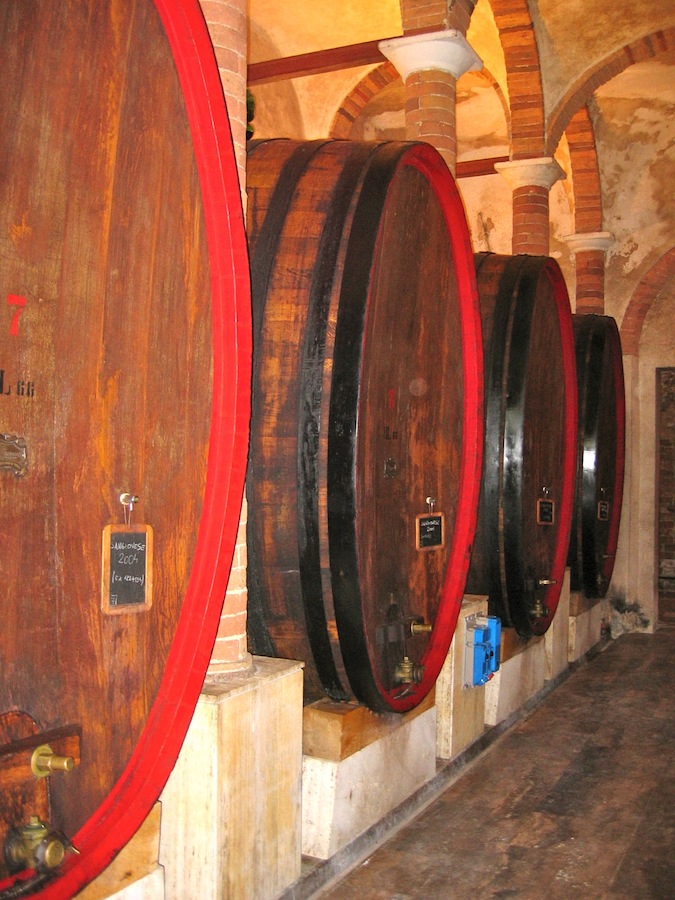
fattoria-felsina-botti-cellar
Whether you're eager to learn more about wine or are just a casual imbiber, sooner or later you're going to encounter our latest Wine Word(s) of the Week: "Old World" & "New World." Knowing both the geographic meaning of these terms as well as the stylistic differences they imply will help you develop your own personal vinous tastes and discover wines that are most likely to please your palate.
Geographically speaking, the term Old World refers to the countries of Europe where winemaking essentially originated. Countries such as France, Italy, Spain, Germany and Portugal, among others, that've been making wine for hundreds and hundreds of years fall squarely under the Old World umbrella.
New World wine regions, on the other hand, are anything outside Europe. Fine winemaking in these regions only developed after the introduction of traditional Old World techniques and Vitis vinifera grape varieties (to learn more, click here). Countries such as the United States, Australia, New Zealand, Chile, Argentina, South Africa and, more recently, China are all considered New World wine regions.
In addition to the geographic distinction, the terms Old World and New World also refer to the style of wine they produce. Old World wines are considered more restrained and understated in terms of aroma, flavor, body and alcohol content relative to New World wines. This is partly because Old World wine regions have cooler climates which prevent the grapes from getting as ripe as they do in the New World. Riper grapes have more sugar which results in higher alcohol levels and fuller-bodied wines. Aromas and flavors of fruit are also more intense in wine made from riper fruit.
So while Old World wines are generally more earthy with reserved aromas and flavors, New World wines are more fruit forward with more intense aromas and flavors.
It is important to note that both styles of wine can be balanced and delicious and neither Old World nor New World wines are "better" than the other despite what you might hear from some wine snobs out there. It's important to do your own vinous research and taste as many wines as you can (how's THAT for homework?) and let your own palate be your guide.
Using the Wine Word(s) in a sentence:
"I prefer the earthiness of Old Word wines over the fruitiness of New World wines."
"Although this wine is from Tuscany, it's made in a more New World style."
"Even though the Malbec grape is from Bordeaux, it now thrives mostly in New World wine regions such as Argentina."
I hope you enjoyed our latest Wine Word(s) of the Week and if you have any "Wine Words" you'd like to learn more about, please feel free to tell me in the Comments section below. To see previous Wine Words of the Week, please click here and, as always, thanks for reading! xo
Whether you’re eager to learn more about wine or are just a casual imbiber, sooner or later you’re going to encounter our latest Wine Word(s) of the Week: “Old World” & “New World.” Knowing both the geographic meaning of these terms as well as the stylistic differences they imply will help you develop your own personal vinous tastes and discover wines that are most likely to please your palate.
Geographically speaking, the term Old World refers to the countries of Europe where winemaking essentially originated. Countries such as France, Italy, Spain, Germany and Portugal, among others, that’ve been making wine for hundreds of years fall squarely under the Old World umbrella. New World wine regions, on the other hand, are anything outside Europe. Fine winemaking in these regions only developed after the introduction of traditional Old World techniques and Vitis vinifera grape varieties (to learn more, click here). Countries including the United States, Australia, New Zealand, Chile, Argentina, South Africa and, more recently, China are all considered New World wine regions.

Large wine barrels or “botti” are primarily used in the Old World wine region of Tuscany
In addition to the geographic distinction, the terms Old World and New World also refer to the style of wine. Old World wines are considered more restrained and understated in terms of aroma, flavor, body and alcohol content relative to New World wines. This is partly because Old World wine regions have cooler climates which prevent the grapes from getting as ripe as they do in the New World. Riper grapes have more sugar which results in higher alcohol levels and fuller-bodied finished wines. Aromas and flavors of fruit are also more intense in wine made from riper fruit. So while Old World wines are generally more earthy with reserved aromas and flavors, New World wines are more fruit forward with more intense aromas and flavors.
It is important to note that both styles of wine can be balanced and delicious and neither Old World nor New World wines are “better” than the other despite what you might hear from some wine snobs out there. It’s important to do your own vinous research and taste as many wines as you can (how’s THAT for homework?) and let your own palate be your guide.
Using the Wine Word(s) in a sentence:
– “I prefer the earthiness of Old Word wines over the fruitiness of New World wines.”
– “Although this wine is from Tuscany, it’s made in a more New World style.”
– “Even though the Malbec grape is from Bordeaux, it now thrives mostly in New World wine regions such as Argentina.”
I hope you enjoyed our latest Wine Word(s) of the Week and if you have any “wine words” you’d like to learn more about, please feel free to tell me in the Comments section below. To see previous Wine Words of the Week, please click here and, as always, thanks for reading!
Cheers,
![]()
The post Wine Word(s) of the Week: “Old World” & “New World” appeared first on The Glamorous Gourmet.
I'm back from the Hamptons after attending one of my favorite Summer food and wine events, the James Beard Foundation's "Chefs & Champagne." From oodles of Champagne to fabulous Celebrity Chefs this event has everything a glamour fan could ask for, AND it also raises funds for the philanthropic work of the Foundation - what's not to love about that? I was smitten the first time I attended in 2014 (click here for the delicious deets) and happy to be back for more. Set amidst the bucolic splendor of Wölffer Estate Vineyard in Sagaponack, NY (they make a FABULOUS rosé!) the 26th annual "Chefs & Champagne" featured delectable dishes from some of the country's most celebrated Chefs paired with an endless supply of bubbles including a brut, rosé and blanc de blancs from Champagne Barons de Rothschild. The pièce de résistance, however, was this year's honoree, one of America's most talented and celebrated Chefs, John Besh.Besh is a multiple James Beard award-winning Chef, cookbook author, philanthropist and restaurateur known for his dedication to and passion for his hometown in Southern Louisiana. Today, he is currently the proprietor of 12 restaurants which celebrate the bounty and traditions of this special region. As a result, this year's "Chefs & Champagne" was dubbed "From the Big Easy to the Big Apple" and a sunkissed and extremely affable Chef Besh kindly took some time to speak with me before the chic Hamptons shindig got underway:
Set amidst the bucolic splendor of Wölffer Estate Vineyard in Sagaponack, NY (they make a FABULOUS rosé!) the 26th annual "Chefs & Champagne" featured delectable dishes from some of the country's most celebrated Chefs paired with an endless supply of bubbles including a brut, rosé and blanc de blancs from Champagne Barons de Rothschild. The pièce de résistance, however, was this year's honoree, one of America's most talented and celebrated Chefs, John Besh.Besh is a multiple James Beard award-winning Chef, cookbook author, philanthropist and restaurateur known for his dedication to and passion for his hometown in Southern Louisiana. Today, he is currently the proprietor of 12 restaurants which celebrate the bounty and traditions of this special region. As a result, this year's "Chefs & Champagne" was dubbed "From the Big Easy to the Big Apple" and a sunkissed and extremely affable Chef Besh kindly took some time to speak with me before the chic Hamptons shindig got underway: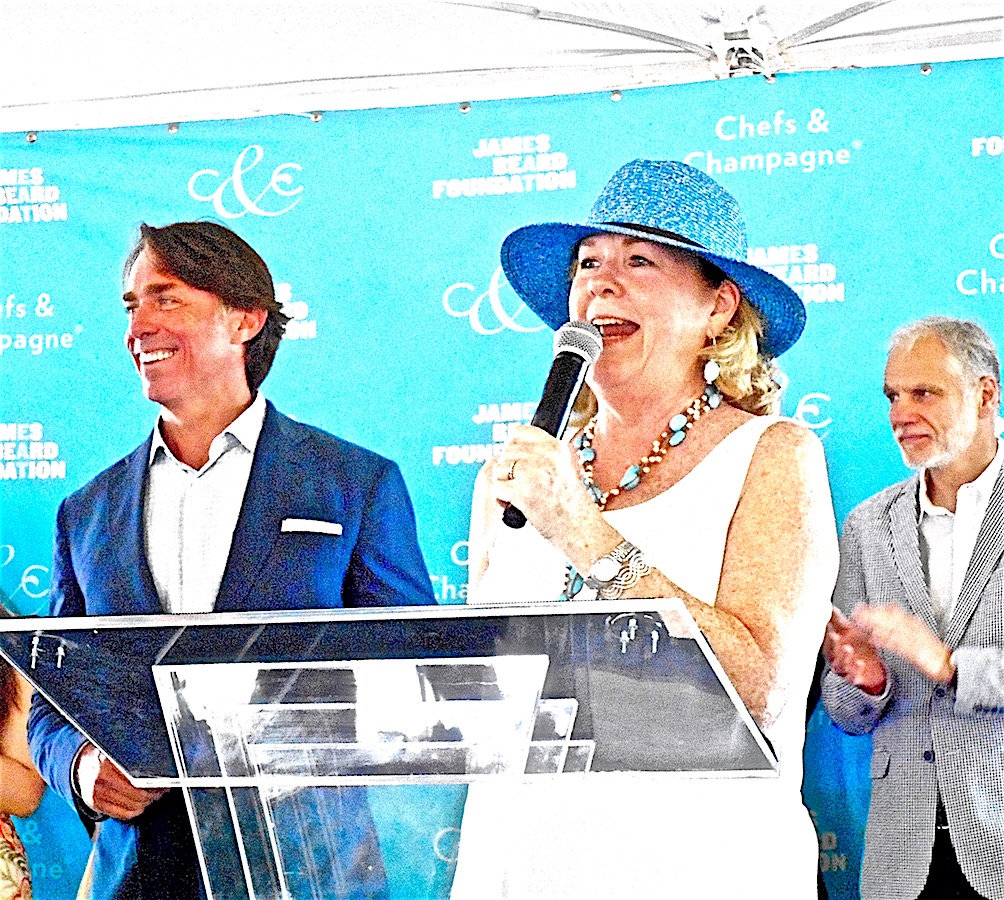

 SM: So how does it feel to be here and be honored at the 2016 "Chefs & Champagne"?JB: Thrilled, tickled to death, it’s humbling. So many greats have been honored by "Chefs & Champagne" & the James Beard Foundation it’s an honor to be included on that list. It also offers a great opportunity to catch up with people I haven’t seen in a while and connect with friends through food.SM: What are some of your favorite Summer flavors?JB: In the Summer, it’s really all about what the garden is giving us. I might have had the best peach of my life yesterday from a farm up here, it was just perfect! Summer’s a time where you really don’t want to manipulate the food a whole lot. I want fresh, big, bold flavors but at the same time I want simplicity. The perfect tomato, basil straight from the garden, what’s not to like?SM: How about something to pair with those flavors? Are you more of a wine or cocktail guy?JB: I’m much more a wine guy than a cocktail guy. I like things like Grüner Veltliner, with light, crisp, green appley flavors to go with shellfish and fish on the grill. Something that’s still going to work with the acidity in tomatoes and salads and things of that nature. So I’m very much white wine centered this time of year.
SM: So how does it feel to be here and be honored at the 2016 "Chefs & Champagne"?JB: Thrilled, tickled to death, it’s humbling. So many greats have been honored by "Chefs & Champagne" & the James Beard Foundation it’s an honor to be included on that list. It also offers a great opportunity to catch up with people I haven’t seen in a while and connect with friends through food.SM: What are some of your favorite Summer flavors?JB: In the Summer, it’s really all about what the garden is giving us. I might have had the best peach of my life yesterday from a farm up here, it was just perfect! Summer’s a time where you really don’t want to manipulate the food a whole lot. I want fresh, big, bold flavors but at the same time I want simplicity. The perfect tomato, basil straight from the garden, what’s not to like?SM: How about something to pair with those flavors? Are you more of a wine or cocktail guy?JB: I’m much more a wine guy than a cocktail guy. I like things like Grüner Veltliner, with light, crisp, green appley flavors to go with shellfish and fish on the grill. Something that’s still going to work with the acidity in tomatoes and salads and things of that nature. So I’m very much white wine centered this time of year.
"Summer’s a time where you really don’t want to manipulate the food a whole lot. I want fresh, big, bold flavors but at the same time I want simplicity." ~ Chef John Besh
SM: Are you a Champagne fan?JB: Big time! Champagne is almost perfect for any occasion, the beginning of a meal, the end of a meal - you could drink Champagne all through the meal and it works! Also, Champagne when it’s hot out with the bubbles and effervescence - it’s a great thing.SM: With all of your restaurants, how do you keep the plates spinning and maintain your high standards of quality and service?JB: Good people. It’s really about finding people who get our philosophy about food and about service and hospitality and giving them the tools and allowing them to percolate up. Investing in passionate people makes all the difference, that’s that one ingredient that you just can’t buy and it’s the difference between good and great.SM: Anything new on the horizon?JB: Well, we’re about to open our Marsh House restaurant with the Thompson Hotel in Nashville so we’re really busy with that and next year at this time we’ll be opening a little Cajun place in Houston called Eunice which we’re really excited about.SM: What’s your favorite part of your professional life right now?JB: Making people happy through food. We also have a foundation where we offer microloans to food producers and culinary school scholarships to inner city and minority youth in New Orleans. Being able to do this, run the restaurants and do good at the same time is it.Following the interview, I mixed and mingled among the fashionable crowd, sampling all the delicious dishes on display. While everything was truly delectable, here are my top 6 faves along with some tasting notes: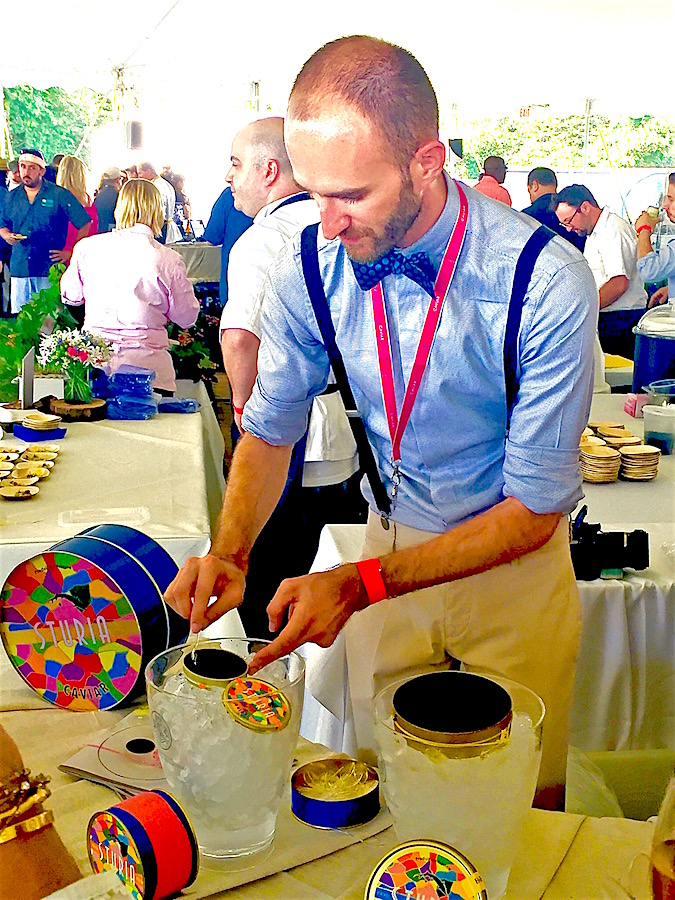 1.) A tasting of 'haute-couture,' French Sturia Caviar featured three selections of spectacular sturgeon roe which culminated in their divine Oscietra Grand Cru Caviar.2.) Chef Dean James Max's (DJM Restaurants) Nantucket Oysters with Uni Vinaigrette: bright, tasty and refreshing, each oyster was crowned with a delightful dollop of uni which accentuated its lovely, briny flavor.
1.) A tasting of 'haute-couture,' French Sturia Caviar featured three selections of spectacular sturgeon roe which culminated in their divine Oscietra Grand Cru Caviar.2.) Chef Dean James Max's (DJM Restaurants) Nantucket Oysters with Uni Vinaigrette: bright, tasty and refreshing, each oyster was crowned with a delightful dollop of uni which accentuated its lovely, briny flavor. 3.) Chef Brian Cheewing's (Wölffer Kitchen, Sag Harbor, NY) Spicy Octopus & Corn Salad with Calabrian Chilies & Micro Cilantro: the combination of textures and flavors was the epitome of Summer and this delicious dish was seasoned to perfection!
3.) Chef Brian Cheewing's (Wölffer Kitchen, Sag Harbor, NY) Spicy Octopus & Corn Salad with Calabrian Chilies & Micro Cilantro: the combination of textures and flavors was the epitome of Summer and this delicious dish was seasoned to perfection!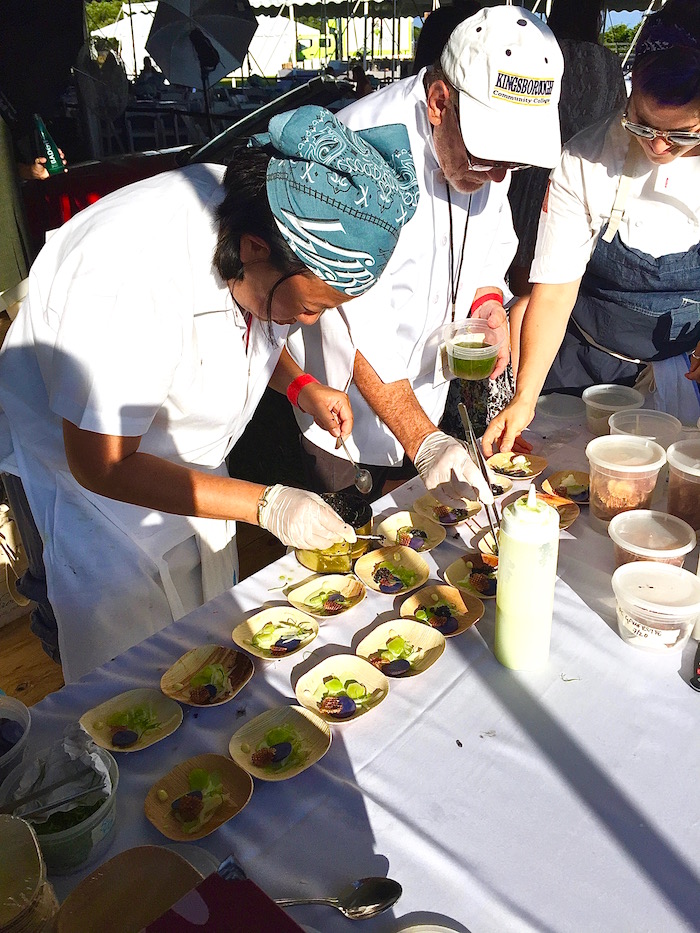 4.) Chef Anita Lo's (Annisa, NYC) Potatoes with Celtuce, Buttermilk Dressing & Sturia Caviar: Chef Lo's mastery of texture and flavor really shined as she incorporated the beautiful flavor of caviar along with creamy dressing and crisp green celtuce.5.) Chef Jeremy Ford's (Matador Room by Jean-Georges, Miami Beach, FL) Foie Gras with Strawberry, Granola and Sorrel: the rich, decadent foie paired outrageously well with the sweet, ripe strawberry and texture of the crunchy granola. The vibrant green baby sorrel also added a lovely pop of color - I could've eaten 5 of them!
4.) Chef Anita Lo's (Annisa, NYC) Potatoes with Celtuce, Buttermilk Dressing & Sturia Caviar: Chef Lo's mastery of texture and flavor really shined as she incorporated the beautiful flavor of caviar along with creamy dressing and crisp green celtuce.5.) Chef Jeremy Ford's (Matador Room by Jean-Georges, Miami Beach, FL) Foie Gras with Strawberry, Granola and Sorrel: the rich, decadent foie paired outrageously well with the sweet, ripe strawberry and texture of the crunchy granola. The vibrant green baby sorrel also added a lovely pop of color - I could've eaten 5 of them! 6.) Pastry Chef Alina Martell (Ai Fiori and Vaucluse, NYC) Profiteroles with Strawberries & Cream: this delightful Summery spin on the beloved classic French dessert was refreshing, comforting and utterly delicious!
6.) Pastry Chef Alina Martell (Ai Fiori and Vaucluse, NYC) Profiteroles with Strawberries & Cream: this delightful Summery spin on the beloved classic French dessert was refreshing, comforting and utterly delicious! Many thanks to all the Glamorous Gourmet Girls who came out to support the 2016 Chefs & Champagne! To view Chef Besh's comments on being honored at this year's event on our YouTube Channel, please click here and for more information on this or any other James Beard Foundation events, please click here. We're already looking forward to 2017 so mark your calendar and hope to see you there!Cheers,
Many thanks to all the Glamorous Gourmet Girls who came out to support the 2016 Chefs & Champagne! To view Chef Besh's comments on being honored at this year's event on our YouTube Channel, please click here and for more information on this or any other James Beard Foundation events, please click here. We're already looking forward to 2017 so mark your calendar and hope to see you there!Cheers,
I’m back from the Hamptons after attending one of my favorite Summer food and wine events, the James Beard Foundation’s “Chefs & Champagne.” From oodles of Champagne to fabulous Celebrity Chefs this event has everything a glamour fan could ask for, AND it also raises funds for the philanthropic work of the Foundation – what’s not to love about that? I was smitten the first time I attended in 2014 (click here for the delicious deets) and happy to be back for more.

Set amidst the bucolic splendor of Wölffer Estate Vineyard in Sagaponack, NY (they make a FABULOUS rosé!) the 26th annual “Chefs & Champagne” featured delectable dishes from some of the country’s most celebrated Chefs paired with an endless supply of bubbles including a brut, rosé and blanc de blancs from Champagne Barons de Rothschild. The pièce de résistance, however, was this year’s honoree, one of America’s most talented and celebrated Chefs, John Besh.
Besh is a multiple James Beard award-winning Chef, cookbook author, philanthropist and restaurateur known for his dedication to and passion for his hometown in Southern Louisiana. Today, he is currently the proprietor of 12 restaurants which celebrate the bounty and traditions of this special region. As a result, this year’s “Chefs & Champagne” was dubbed “From the Big Easy to the Big Apple” and a sunkissed and extremely affable Chef Besh kindly took some time to speak with me before the chic Hamptons shindig got underway:

James Beard Foundation President, Susan Ungaro, introduces Honoree Chef John Besh


SM: So how does it feel to be here and be honored at the 2016 “Chefs & Champagne”?
JB: Thrilled, tickled to death, it’s humbling. So many greats have been honored by “Chefs & Champagne” & the James Beard Foundation it’s an honor to be included on that list. It also offers a great opportunity to catch up with people I haven’t seen in a while and connect with friends through food.
SM: What are some of your favorite Summer flavors?
JB: In the Summer, it’s really all about what the garden is giving us. I might have had the best peach of my life yesterday from a farm up here, it was just perfect! Summer’s a time where you really don’t want to manipulate the food a whole lot. I want fresh, big, bold flavors but at the same time I want simplicity. The perfect tomato, basil straight from the garden, what’s not to like?
SM: How about something to pair with those flavors? Are you more of a wine or cocktail guy?
JB: I’m much more a wine guy than a cocktail guy. I like things like Grüner Veltliner, with light, crisp, green appley flavors to go with shellfish and fish on the grill. Something that’s still going to work with the acidity in tomatoes and salads and things of that nature. So I’m very much white wine centered this time of year.
“Summer’s a time where you really don’t want to manipulate the food a whole lot. I want fresh, big, bold flavors but at the same time I want simplicity.” ~ Chef John Besh
SM: Are you a Champagne fan?
JB: Big time! Champagne is almost perfect for any occasion, the beginning of a meal, the end of a meal – you could drink Champagne all through the meal and it works! Also, Champagne when it’s hot out with the bubbles and effervescence – it’s a great thing.
SM: With all of your restaurants, how do you keep the plates spinning and maintain your high standards of quality and service?
JB: Good people. It’s really about finding people who get our philosophy about food and about service and hospitality and giving them the tools and allowing them to percolate up. Investing in passionate people makes all the difference, that’s that one ingredient that you just can’t buy and it’s the difference between good and great.
SM: Anything new on the horizon?
JB: Well, we’re about to open our Marsh House restaurant with the Thompson Hotel in Nashville so we’re really busy with that and next year at this time we’ll be opening a little Cajun place in Houston called Eunice which we’re really excited about.
SM: What’s your favorite part of your professional life right now?
JB: Making people happy through food. We also have a foundation where we offer microloans to food producers and culinary school scholarships to inner city and minority youth in New Orleans. Being able to do this, run the restaurants and do good at the same time is it.
Following the interview, I mixed and mingled among the fashionable crowd, sampling all the delicious dishes on display. While everything was truly delectable, here are my top 6 faves along with some tasting notes:

1.) A tasting of ‘haute-couture,’ French Sturia Caviar featured three selections of spectacular sturgeon roe which culminated in their divine Oscietra Grand Cru Caviar.
2.) Chef Dean James Max’s (DJM Restaurants) Nantucket Oysters with Uni Vinaigrette: bright, tasty and refreshing, each oyster was crowned with a delightful dollop of uni which accentuated its lovely, briny flavor.

Spicy Octopus & Corn Salad with Calabrian Chilies & Micro Cilantro
3.) Chef Brian Cheewing’s (Wölffer Kitchen, Sag Harbor, NY) Spicy Octopus & Corn Salad with Calabrian Chilies & Micro Cilantro: the combination of textures and flavors was the epitome of Summer and this delicious dish was seasoned to perfection!

Chef Anita Lo works her magic with Sturia Caviar!
4.) Chef Anita Lo’s (Annisa, NYC) Potatoes with Celtuce, Buttermilk Dressing & Sturia Caviar: Chef Lo’s mastery of texture and flavor really shined as she incorporated the beautiful flavor of caviar along with creamy dressing and crisp green celtuce.
5.) Chef Jeremy Ford’s (Matador Room by Jean-Georges, Miami Beach, FL) Foie Gras with Strawberry, Granola and Sorrel: the rich, decadent foie paired outrageously well with the sweet, ripe strawberry and texture of the crunchy granola. The vibrant green baby sorrel also added a lovely pop of color – I could’ve eaten 5 of them!

6.) Pastry Chef Alina Martell (Ai Fiori and Vaucluse, NYC) Profiteroles with Strawberries & Cream: this delightful Summery spin on the beloved classic French dessert was refreshing, comforting and utterly delicious!

Many thanks to all the Glamorous Gourmet Girls who came out to support the 2016 Chefs & Champagne! To view Chef Besh’s comments on being honored at this year’s event on our YouTube Channel, please click here and for more information on this or any other James Beard Foundation events, please click here. We’re already looking forward to 2017 so mark your calendar and hope to see you there!
Cheers,
![]()
The post Chef John Besh Honored at James Beard Foundation’s “Chefs & Champagne” appeared first on The Glamorous Gourmet.